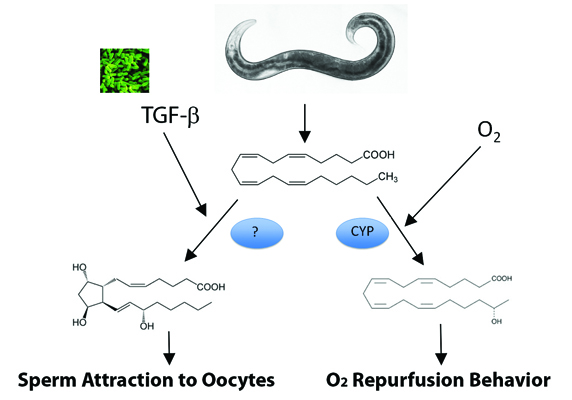C. elegans studies uncover roles for eicosanoids in development and stress
Eicosanoids are powerful, short-range signaling molecules derived by oxygenation of 20-carbon polyunsaturated fatty acids, or PUFAs. These effectors, including prostaglandins, leukotrienes and thromboxanes, are produced in mammals by cyclooxygenase and lipoxygenase enzymes and act as regulators of pain, inflammation, immunity, blood pressure and reproduction. Two recent studies indicate that eicosanoids generated by cyclooxygenase-independent pathways mediate reproductive and behavioral functions in the roundworm Caenorhabditis elegans.
Prostaglandins and other eicosanoids are produced in many invertebrates, although their are not well understood. There is for cyclooxygenase or lipoxygenase enzyme activities in C. elegans, even though these nematodes synthesize a wide range of 20-carbon PUFAs, including arachidonic acid and eicosapentaenoic acid (, and). Synthesis of PUFAs is important, because C. elegans mutants that lack the ability to insert double bonds in fatty acids display a range of developmental and neurological defects (, , and ). The new studies describe crucial functions for specific eicosanoids derived from PUFAs.

Sperm must locate an oocyte for successful reproduction. In C. elegans, sperm attraction to oocytes requires PUFAs, which are precursors for F-class prostaglandins synthesized independently of cyclooxygenase activity (, and ). Recently, Michael Miller’s group at the University of Alabama showed that pheromone-sensing neurons in the C. elegans nose secrete a TGF-β ligand that stimulates the cyclooxygenase-independent synthesis of PGF1α and PGF2α in the germ line during favorable . When food is limited and nematode crowding occurs, secreted ascaroside pheromones reduce . TGF-β levels in neurons signal through conserved pathways to regulate R-Smad activity in developing oocytes, which inhibits the conversion of PUFAs into . When fewer prostaglandins are produced by oocytes, sperm are less efficient at locating the fertilization site, leading to reduced fertilization rate. Thus, environmental conditions sensed by females ultimately affect sperm function.
The C. elegans genome also encodes several PUFA-metabolizing cytochrome P450 enzymes, or CYPs, which convert eicosapentaenoic acid and arachidonic acid to epoxide and hydroxyl derivatives (, and ). A recent study from H. Robert Horvitz’s lab at the Massachusetts Institute of Technology used an unbiased genetic screen to discover a role for polyunsaturated fatty acids and CYP-13A12 in an eicosanoid-mediated response to a movement behavior that occurs after oxygen deprivation followed by . In mammals, oxygen deprivation followed by reoxygenation causes reperfusion injury due to inflammation and oxidative damage. In C. elegans, this damage can be modeled by examining movement increases that occur after the transfer of worms from no oxygen to 20 percent oxygen. The EGL-9 protein uses molecular oxygen to hydroxylate the hypoxia-inducing factor, or HIF, inhibiting HIF transcriptional activity. Pre-exposure to low oxygen concentrations or inhibition of EGL-9 activity protects mammals from reperfusion injury and blocks the C. elegans movement response. The Horvitz study showed that in the presence of oxygen, CYP-13A12 produces eicosanoids that drive the .
Thus, C. elegans provides a means to dissect phenotypes and pathways employing cyclooxygenase-independent synthesis of eicosanoids. Importantly, cyclooxygenase-independent synthesis of F-class prostaglandins also has been . Furthermore, CYP-generated eicosanoids likely are involved in more diverse physiological responses than previously appreciated.
Enjoy reading 91—«…´¥´√Ω Today?
Become a member to receive the print edition four times a year and the digital edition monthly.
Learn moreGet the latest from 91—«…´¥´√Ω Today
Enter your email address, and we’ll send you a weekly email with recent articles, interviews and more.
Latest in Science
Science highlights or most popular articles

Unraveling oncogenesis: What makes cancer tick?
Learn about the 91—«…´¥´√Ω 2025 symposium on oncogenic hubs: chromatin regulatory and transcriptional complexes in cancer.

Exploring lipid metabolism: A journey through time and innovation
Recent lipid metabolism research has unveiled critical insights into lipid‚Äìprotein interactions, offering potential therapeutic targets for metabolic and neurodegenerative diseases. Check out the latest in lipid science at the 91—«…´¥´√Ω annual meeting.

Melissa Moore to speak at 91—«…´¥´√Ω 2025
Richard Silverman and Melissa Moore are the featured speakers at the 91—«…´¥´√Ω annual meeting to be held April 12-15 in Chicago.

A new kind of stem cell is revolutionizing regenerative medicine
Induced pluripotent stem cells are paving the way for personalized treatments to diabetes, vision loss and more. However, scientists still face hurdles such as strict regulations, scalability, cell longevity and immune rejection.

Engineering the future with synthetic biology
Learn about the 91—«…´¥´√Ω 2025 symposium on synthetic biology, featuring applications to better human and environmental health.

Scientists find bacterial ‘Achilles’ heel’ to combat antibiotic resistance
Alejandro Vila, an 91—«…´¥´√Ω Breakthroughs speaker, discussed his work on metallo-Œ≤-lactamase enzymes and their dependence on zinc.

